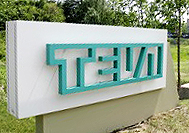8. Teva $17.5B ▲14.0%
Global revenue: $26.0B (9th), up 8.6%
Top brands: Copaxone ($3.9B); Proair HFA ($1.2B); Qvar ($695M)
Promotional spend: $328M (2oth); 1.9% of rev.
R&D spend: $1.5B (17th); up 4.3%; 5.8% of rev.
Planned launches: CEP-33237 ER hydrocone (CNS); Laquinimod (CNS); reslizumab (resp.)
Patent expirations: Nuvigil (2016); Azilect (2017)
The Israeli drugmaker’s future looks a lot brighter than it did just a year ago. In CEO Erez Vigodman’s first months on the job, Teva overhauled its management structure and shuttered several manufacturing plants, eventually trimming $600 million in net costs. Refocusing on its core strengths of generics and specialty medications, the leaner Teva launched four new products—including Adasuve, an inhalation powder to treat schizophrenia—that generated $200 million. A favorable Supreme Court ruling delayed generic competition to profit-center MS drug Copaxone, giving patients more time to switch to its longer-lasting successor. Finally, the FDA pushed back the launch date of Mylan’s generic version of Nexium, making Teva the sole US generic Nexium producer for the next several months. House back in order, the company opted to join the M&A craze gripping the pharmaceutical industry. In April it announced plans to strengthen its position in neurological R&D with a $3.2-billion purchase of California biotech firm Auspex Pharmaceuticals, whose new treatment for Huntington’s chorea, SD-908, recently passed Phase-III trials.
Click here to return to main story.
From the May 01, 2015 Issue of MM+M - Medical Marketing and Media








